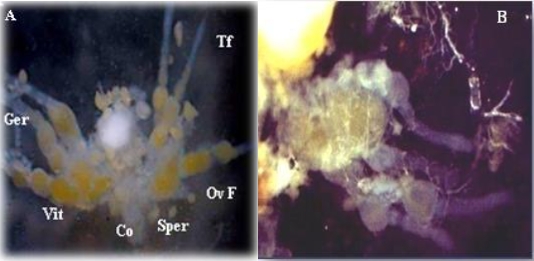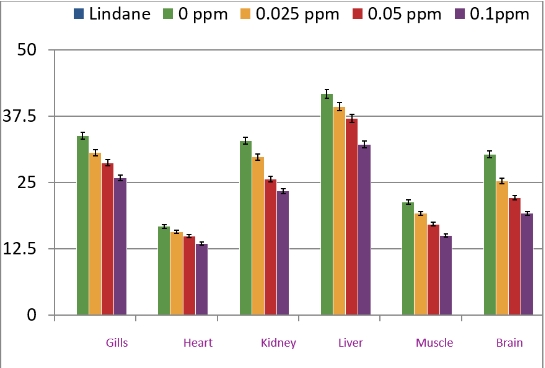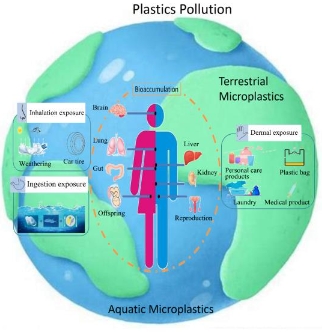Evaluation of the crude chitinases toxicity on the reproductive system of Callosobruchus maculatus (Coleoptera: Bruchidae)
Abstract
Insecticides represent the most used control method against the insect pests of stored food products. But there are strains of insects that are resistant to these insecticides; this is the case of the beetle of the chickpea, Callosobruchus maculatus. The present study has for objective the evaluation of the biological activity of chitinolytic enzymes extracted from the fish offals Scorpaena scrofa (scorpion fish) on this beetle at different doses (3%, 6%, 9%, 12%, 15%, and 21%) prepared with the buffer solution. The results obtained from three treatments (T1, T2, and T3) realized according to the dose of the crude enzyme and the time of exposure were compared with those of the controls and have shown a very significant efficiency of our crude enzyme on the reduction of the fertility rate of 100% by treating the couple (T1) at the same time as to treat the male (T3) and the female (T2) separately with the strongest dose (21%) for 48 h of exposure. It would be thus desirable to demonstrate the activity of these enzymes in the real conditions of storage.
References
[1]Kellouche A, Soltani N. Biological activity of five plant powders and one plant essential oil on Callosobruchus maculatus (F.) (French). International Journal of Tropical Insect Science. 2004; 24(2). doi: 10.1079/ijt200420
[2]Malunga LN, Bar-El SD, Zinal E, et al. The potential use of chickpeas in development of infant follow-on formula. Nutrition Journal. 2014; 13(1). doi: 10.1186/1475-2891-13-8
[3]Rasheed A, Saad Al J, Sun BF, et al. Efficacy of Various Plant Extracts and Synergism Against Domestic Species of Rice Weevil Sitophilous Oryzae (Curculionidae: Coleoptera). Polish Journal of Environmental Studies. 2024; 33(4): 1-12.
[4]Chia XK, Hadibarata T, Kristanti RA, et al. The function of microbial enzymes in breaking down soil contaminated with pesticides: a review. Bioprocess and Biosystems Engineering. 2024; 47(5): 597-620. doi: 10.1007/s00449-024-02978-6
[5]Benhalima H, Chaudhry MQ, Mills A, Price NR. Phosphine resistance in stored—product insects collected from various grain storage facilities in Morocco. Journal of Stored Products Research. 2004; 40: 241-249.
[6]Kazemi F, Talebi AA, Fathipour Y, Farahani S. A comparative study on the effect of four leguminous species on biological and population growth parameters of Callosobruchus maculatus (F.) (col: Bruchidae). Advances in Environmental Biology. 2009; 3(3): 226-232.
[7]Adegorite SO, Aladesida AA, John IB, kayode-Isola TM. Bioefficacy of Chenopodium ambrosioides L. (Chenopodiaceae) on adult Callosobruchus maculatus F. (Coleoptera: Bruchidae). World Journal of Biology Pharmacy and Health Sciences. 2024; 17(2): 192-200. doi: 10.30574/wjbphs.2024.17.2.0039
[8]Tengey TK, Alidu SM, Moro A, et al. Resistance to Callosobruchus maculatus among cowpea (Vigna unguiculata (L.) Walp) genotypes. Journal of Crop Improvement. 2023; 37: 309-322. doi: 10.1080/15427528.2022.2092573
[9]Saguez J, Dubois F, Vincent C, et al. Differential aphicidal effects of chitinase inhibitors on the polyphagous homopteran Myzus persicae (Sulzer). Pest Management Science. 2006; 62(12): 1150-1154. doi: 10.1002/ps.1289
[10]Laribi-Habchi H, Dziril M, Badis A, et al. Purification and Characterization of a Highly Thermostable Chitinase from the Stomach of the Red Scorpion fish Scorpaena scrofa with Bioinsecticidal Activity toward Cowpea Weevil Callosobruchus maculatus (Coleoptera: Bruchidae). Bioscience, Biotechnology, and Biochemistry. 2012; 76(9): 1733-1740. doi: 10.1271/bbb.120344
[11]Mitsohiro U, Yukiko K, Aji S, et al. Purification and Characterization of Chitinase B from Moderately Thermophilic Bacterium Ralstonia sp. A-471. Bioscience, Biotechnology, and Biochemistry. 2005; 69(4): 842-844. doi: 10.1271/bbb.69.842
[12]Chia XK, Hadibarata T, Ayu R, et al. The function of microbial enzymes in breaking down soil contaminated with pesticides: a review. Bioprocess and Biosystems Engineering. 2024; 47: 597-620.
[13]Wang X, Ding X, Gopalakrishanan B, et al. Characterization of a 46 KDa insect chitinase from transgenic tobacco. Insect Biochemistry and Molecular Biology. 1996; 26: 1055-1064.
[14]Lorito M, Woo SL, Fernandez IG, et al. Genes from mycoparasitic fungi as a source for improving plant resistance to fungal pathogens. Proceedings of the National Academy of Sciences. 1998; 95(14): 7860-7865. doi: 10.1073/pnas.95.14.7860
[15]Gongora CE, Wang S, Barbehenn RV, et al. Chitinolytic enzymes from Streptomyces albidoflavus expressed in tomato plants: effects on Trichoplusia ni. Entomologia Experimentalis et Applicata. 2001; 99(2): 193-204. doi: 10.1046/j.1570-7458.2001.00817
[16]Carstens M, Vivier MA, Pretorius IS. The Saccharomyces cerevisiae chitinase, encoded by the CTSI-2 gene, confers antifungal activity against Botrytis cinerea to transgenic tobacco. Trangenic Research. 2003; 12(4): 497-508.
[17]Fitches E, Wilkinson H, Bell H, et al. Cloning, expression and functional characterisation of chitinase from larvae of tomato moth (Lacanobia oleracea): a demonstration of the insecticidal activity of insect chitinase. Insect Biochemistry and Molecular Biology. 2004; 34: 1037-1050.
[18]Saguez J, Hainez R, Cherqui A, et al. Unexpected effects of chitinases on the peach-potato aphid (Myzus persicae Sulzer) when delivred via transgenic potato plants (Solanum tuberosum Linné) and in vitro. Transgenic Research. 2005; 14(1): 57-67. doi: 10.1007/s11248-004-3100-4
[19]Lawrence SD, Novak NG. Expression of Poplar Chitinase in Tomato Leads to Inhibition of Development in Colorado Potato Beetle. Biotechnology Letters. 2006; 28(8): 593-599. doi: 10.1007/s10529-006-0022-7
[20]Fiandra L, Terracciano I, Fanti P, et al. A viral chitinase enhances oral activity of TMOF. Insect Biochemistry and Molecular Biology. 2010; 40(7): 533-540. doi: 10.1016/j.ibmb.2010.05.001
[21]Laribi-Habchi H, Bouacem K, Allala F, et al. Characterization of chitinase from Shewanella inventionis HE3 with bio-insecticidal effect against granary weevil, Sitophilus granarius Linnaeus (Coleoptera: Curculionidae). Process Biochemistry. 2020; 97: 222-233. doi: 10.1016/j.procbio.2020.06.023
[22]Dziril M, Grib H, Laribi-Habchi H, et al. Chitin oligomers and monomers production by coupling γ radiation and enzymatic hydrolysis. Journal of Industrial and Engineering Chemistry. 2015; 26: 396-401. doi: 10.1016/j.jiec.2014.12.015
[23]Bouacem K, Laribi-Habchi H, Mechri S, et al. Biochemical characterization of a novel thermostable chitinase from Hydrogenophilus hirschii strain KB-DZ44. International Journal of Biological Macromolecules. 2018; 106: 338-350. doi: 10.1016/j.ijbiomac.2018.08.026
[24]Yahiaoui M, Laribi-Habchi H, Bouacem K, et al. Purification and biochemical characterization of a new organic solvent-tolerant chitinase from Paenibacillus timonensis strain LK-DZ15 isolated from the Djurdjura Mountains in Kabylia, Algeria. Carbohydrate Research. 2019; 483: 107747. doi: 10.1016/j.carres.2019.107747
[25]Yuichiro K, Masaki K, Royoji M, et al. Structure of full-length class I chitinase from rice revealed by X-ray crystallography and small-angle X-ray scattering. Proteins: Structure, Function, and Bioinformatics. 2010; 78(10): 2295-2305. doi: 10.1002/prot.22742
[26]Laribi-Habchi H, Biche M, Drouiche N, et al. Effectiveness of a biological insecticide derived from Scorpion fish offal against the chickpea weevil. Journal of Bioprocessing & Biotechniques. 2014; 2: 1-4. doi.org/10.1111/jfpp.12354
[27]Neetu D, Rupinder T, Gurinder SH. Biotechnological aspects of chitinolytic enzymes: A review. Applied Microbiology and Biotechnology. 2006; 71(6): 773-782. doi: 10.1007/s00253-005-0183-7
[28]Kondreddy A, Kottapalli S, Appa RP. A simple, rapid and yet less expensive method to detect chitinase in agarose plates. Journal of Biochemical and Biophysical Methods. 2007; 70(4): 683-684. doi: 10.1016/j.jbbm.2007.01.015
[29]Baldrian P, Voříšková J, Dobiášová P, et al. Production of extracellular enzymes and degradation of biopolymers by saprotrophic microfungi from the upper layers of forest soil. Plant and Soil. 2010; 338(1-2): 111-125. doi: 10.1007/s11104-010-0324-3
[30]Hamed I, Özogul F, Regenstein JM. Industrial applications of crustacean by-products (chitin, chitosan, and chitooligosaccharides): A review. Trends in Food Science & Technology. 2016; 48: 40-50. doi: 10.1016/j.tifs.2015.11.007
[31]Younes I, Rinaudo M. Chitin and Chitosan Preparation from Marine Sources. Structure, Properties and Applications. Marine Drugs. 2015; 13(3): 1133-1174. doi: 10.3390/md13031133
[32]Mechri S, Sellem I, Bouacem K, et al. A biological clean processing approach for the valorization of speckled shrimp Metapenaeus monoceros by-product as a source of bioactive compounds. Environmental Science and Pollution Research. 2020; 27(13): 15842-15855. doi: 10.1007/s11356-020-08076
[33]Laribi-Habchi H, Biche M, Drouiche N, et al. Efficacy of Crude and Purified Chitinases (SsChi50) Extracted from Offal Red Scorpion Fish in Biological Control of Chickpea Weevil (Callosobruchus maculatus L.). Journal of Food Processing and Preservation. 2014; 39(6): 1355-1360. doi: 10.1111/jfpp.12354
[34]Fabricius JC. The System of Entomology: Consisting of Insect Classes, Orders, Genera, Species, Additional Synonyms, Localities, Descriptions, Observations (Latin). Flensbvrgi et Lipsiae: In Officina Libraria Kortii; 1775.
[35]Lee SC, Gepts PL, Whitaker JR. Protein Structures of Common Bean (Phaseolus vulgaris) α-Amylase Inhibitors. Journal of Agricultural and Food Chemistry. 2002; 50(22): 6618-6627. doi: 10.1021/jf020189t
[36]Reissig JL, Strminger JL, Leloir LF. Amodified colorimetric method for the estimation of N-acetylamino sugars. The Journal of Biological Chemistry. 1955; 217: 959-967.
[37]Mbata GN, Ekpendu OT. The insecticidal action of four botanicals [Mitracarpus scaber, Napoleona imperialis, Piper guineense, Diodia sarmentosa] against three storage beetles [Callosobruchus maculatus, Callosobruchus subinnotatus, Sitophilus]. Food and Agriculture Organization of the United Nations. 1992; 44(3): 723-733.
[38]Nardon P. Ovogenesis and transmission of symbiotic bacteria in the weevil Sitophilus oryzae L. (Coleoptera: Curculionoidea) (French). Annales de la Société entomologique de France (NS). 2006; 42(2): 129-164. doi: 10.1080/00379271.2006.10700618
[39]Wiwat C, Thaithanun S, Pantuwatana S, et al. Toxicity of Chitinase-Producing Bacillus thuringiensis ssp. kurstaki HD-1 (G) toward Plutella xylostella. Journal of Invertebrate Pathology. 2000; 76(4): 270-277. doi: 10.1006/jipa.2000.4976
[40]Laribi-Habchi H, Bouanane-Darenfed A, Drouiche N, et al. Purification, characterization, and molecular cloning of an extracellular chitinase from Bacillus licheniformis stain LHH100 isolated from wastewater samples in Algeria. International Journal of Biological Macromolecules. 2015; 72: 1117-1128. doi: 10.1016/j.ijbiomac.2014.10.035
[41]Rishad KS, Rebello S, Nathan VK, et al. Optimised production of chitinase from a novel mangrove isolate, Bacillus pumilus MCB-7 using response surface methodology. Biocatalysis and Agricultural Biotechnology. 2016; 5: 143-149. doi: 10.1016/j.bcab.2016.01.009
Copyright (c) 2024 Laribi-Habchi Hassiba, Amrouche Zoheir, Boudjamaa Nouara, Mohamed Mahmoud Fadhila, Medjdoub Ouafaa, Akroum-Amrouche Dahbia, Akroum Hamza

This work is licensed under a Creative Commons Attribution 4.0 International License.








